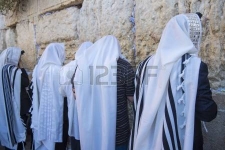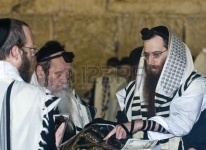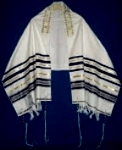|
"Once it is understood that
believers today are not under obligation of
Mosaic Law, . . . confusions and disputes are
answered." |
If you’ve ever
visited the most holy site in the Jewish world today, the
Kotel, the Western Wall in Jerusalem, or have even seen
photos, you could not help but be impressed by the visual
sight of religious devotion. Dozens of Orthodox Jewish men
wrapped in their long striped prayer shawls, rocking back
and forth and praying at that place sometimes known as the
Wailing Wall.
The prayer shawl that they wear is known in Hebrew as a
Tallit. A traditional Tallit is rectangular and has stripes
of either blue or black, along with specially tied tassels
at the 4 corners. The Hebrew word for those tassels is
Tzitzit, and since they are commanded in scripture, they are
the real reason that the Tallit is worn.
As believers in Messiah Jesus who desire to be familiar with
the Jewish context of the New Testament narrative, this is
something basic to our understanding of that world. Let’s
look at the core verse in Mosaic Law with the command:
| The
LORD said to Moses, "Speak to the people of
Israel, and tell them to make tassels on the
corners of their garments throughout their
generations, and to put a cord of blue on the
tassel of each corner. And it shall be a tassel
for you to look at and remember all the
commandments of the LORD, to do them, not to
follow after your own heart and your own eyes,
which you are inclined to play the harlot. ”
~ Numbers 15:37-39 ~ |
The command is repeated
in summery form in Deuteronomy 22:12.
We need to distinguish between two types of Tallit that are
worn by Jewish men:
- The Tallit Gadol is the familiar prayer shawl which is
worn around the shoulders. This is supposed to be worn by
all Jewish men participating in certain religious activities
such as a Torah service in a synagogue.
- The Tallit Katan is a light vest which is worn under the
outer garment. This vest is worn almost exclusively by
Orthodox Jewish men, those who are committed to Mosaic Law
observance. The Tallit Katan is worn at all times during
waking hours, not just during religious ceremonies.
What they both have in common is that they have the Tzitzit
tassels tied on each of the four corners of the garment,
which is the focus of the Biblical command.
You may have noticed that we keep saying that the Tallit is
a command for men, but have not mentioned women. If asked
about this, the standard Orthodox Jewish response is to say
that while women are obligated to not transgress the
negative commands of Mosaic Law, i.e. the “thou shalt nots”,
they are not obligated to abide by the positive commands of
Torah, the “thou shalls."
In recent years the Conservative and Reform branches of
Judaism, the centrist and liberal movements respectively,
under pressure, have permitted the wearing of any Jewish
religious article to both men and women, whether it be the
Tallit Prayer Shawl, the Kippah head covering or the
Tefillin, leather Scripture boxes worn on the arm and head.
Going back to the passage in Numbers, the command to wear
the tassels was intended to remind the people of Israel that
they were a unique possession of the Lord, they were in a
covenant relationship to Him and were obligated to keep the
commands of Mosaic Law. In modern terms, it would be like
going around with a small Bible worn on a string around your
neck.
Because the Jewish people were the only ones wearing such
tassels on the corners of their garments, they would
certainly be reminded of their unique status and obligation.
Additionally, the tassels on the four corners are not
random, but rather are several inches long and according to
rabbinic tradition are tied in a certain specific pattern.
The instructions for the intricate pattern results in a
total of 613 loops and knots when all four tassels are added
up, the same number of laws, 613, in the Mosaic Law.
The Numbers 15 passage also instructs that within each
tassel there was to be a cord of blue. In the ancient world
the color blue as a dye was rare and expensive. While there
is some dispute, the consensus is that the dye was derived
from a crushed snail that is native to the Mediterranean
Sea. Because of the dispute regarding the origin of the dye,
most Jewish authorities directed that the Tzitzit simply be
white. In recent years the snail that produces the dye was
rediscovered in the waters off Israel and some Orthodox Jews
have resumed inserting the blue cord, while some Messianic
Jews have used a blue cord in their Tzitzit for years.
As a Jewish man born under the law (Galatians 4:4), Messiah
Yeshua lived during the Dispensation of Mosaic Law, and He
voluntarily subjected himself to all the provisions of that
law. He would have worn the Tallit Katan at all times, with
the likelihood that His was of a long robe length, with the
Tzitzit tassels below the knee. We see this illustrated in
the passage where Jesus was passing through a crowd and a
woman reached out to touch the fringe of his garment:
|
Suddenly, a woman who had a flow of blood for
twelve years came from behind and touched the
fringe of His garment. For she said to herself,
“If only I may touch His garment, I shall be
made well.”
~ Matthew
9:20 ~ |
Some translations use the
word "hem," but a better rendering is "fringe" as in the
Tzitzit fringe on the four corners of the Tallit that Yeshua
was wearing. She believed the Jewish tradition of that day
that if one touched the Tzitzit of a truly holy man, they
would be healed.
The next verse gives the result:
| But
Jesus turning and seeing her said, “Daughter,
take courage; your faith has made you well.” At
once the woman was made well. |
The woman was healed by
her genuine faith that Yeshua was the Holy Son of God, not
by a tradition of the Tzitzit.
So yes, that means Messiah Jesus wore a Tallit. Again, it
must be remembered that He voluntarily wore them during the
period in which Mosaic Law was the “rule of life” for Jewish
believers. Believers today are no longer under the
obligation of mandatory Mosaic Law keeping, which came to an
end when the Dispensation of Mosaic Law ended at the cross.
(See Ariel Messianic Bible Study #137 for a discussion of
this.) This reinforces an additional lesson: simply because
Jesus did something during the time He was on earth is not
equivalent to that action being a commandment for believers
today. This has become a disputed issue in parts of the
Messianic Movement as well as the Hebrew Roots movement,
segments of which teach a current obligation to keep all of
these physical items in Mosaic Law. They pressure the
doubtful with the line: “If Jesus did these things,
shouldn’t you?”
Once it is understood that believers today are not under
obligation of Mosaic Law, these confusions and disputes are
answered.
So that brings us to an interesting point: Messiah Yeshua
kept Mosaic Law as seen in the two passages above. Yet in
Matthew 23:5 He cautions against the misuse of those fringes
by saying that they had. In this way their observance of
this commandment would be noticed and seen by all. That is
why Messiah charges them with putting on a religious show
for appearance’s sake.
Thus, we are reminded of the verse:
Man looks at the outward appearance, but God looks upon
the heart (1 Samuel 16:7).
While I dearly value my Jewish heritage and love and
practice the culture (1 Cor. 9:20), I need to ask: Do I ever
do things for the sake of religious appearance? Do you? It’s
a sobering question we must ask ourselves. As believers in
Messiah Yeshua we know that He has promised that He will
write his word and his will upon hearts that are soft,
hearts that are truly yielded to him. Let’s not
broaden the straps of our
phylacteries and do things for the sake of
religious appearance, but let’s be yielded so He can
accomplish His will through our lives.
Tallit: The Jewish Prayer Shawl
~ a messianic study ~
© Mottel Baleston, 2016



